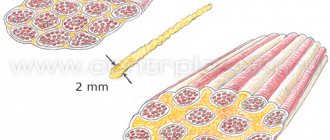At different stages of life, representatives of the fair sex note changes in breast size, and their reduction is especially distressing. This is a cause for concern, which is quite justified: the problem may not only be of an aesthetic nature.
To fully reveal the reasons for such phenomena, let us consider the structure of the female breast.
How do women's breasts work?
The female breast is an organ that consists of two hemispheres located symmetrically. The basis of the breast is gland, or glandular tissue, formed by 15-20 glandular lobes. In turn, the lobes consist of small spheres - alveoli, which produce milk during lactation.
The glandular tissue is surrounded on all sides by adipose tissue, which is also located between the lobes.
The gland is attached to the pectoral muscles by connective tissue. In the chest itself, contrary to a well-known misconception, there are no muscles. From the inside it is permeated with ligaments intertwined with each other. This is a kind of frame that supports the breasts and prevents sagging.
The ratio of glandular and adipose tissue, as well as the amount of connective tissue present, is individual for each woman.
Why are breasts shrinking?
Anatomically, a reduction in the size of a woman’s breasts can result from a reduction in the amount of fatty or glandular tissue that forms it.
This is facilitated by reasons that can be divided into two groups.
- Reasons of a physiological nature: cyclical hormonal fluctuations, pregnancy and lactation, weight loss, sports, age-related changes.
- Pathological causes associated with diseases of internal organs (including cancer), endocrine and hormonal disorders.
The female breast is a target organ that is affected by many factors, including lifestyle, general condition of the body and the action of various hormones. Bust reduction is an indicator reflecting these processes.
Inconsistency in size
During certain periods of life, women note that their breasts either decrease or increase in size. Why this happens depends on the specific circumstances.
The female body is designed in such a way that it is largely controlled by hormonal levels. The size of the mammary glands changes under the influence of hormonal changes. The main hormones whose action affects breast size: estrogens, progesterone, prolactin.
Menstruation and breast size
A peculiarity of the female hormonal system: with each menstrual cycle, the body prepares for the possible conception and bearing of a child. Therefore, at different periods of the cycle, the size of the bust changes: before the onset of menstruation, the mammary glands increase in size, and immediately after their onset, the breasts decrease.
Estrogen has the greatest influence on the course of the menstrual cycle and, accordingly, the cyclic change in the size of the mammary glands.
On the eve of menstruation, the concentration of hormones of this group in the blood increases, which leads to fluid retention in the body, including between the lobes in the mammary glands. This mechanism is provided by nature to create favorable conditions for fertilization of the egg.
The result is an increase in the bust by a size or more, pain, and a feeling of swelling.
Immediately after the start of menstruation, the mammary glands shrink, regaining their original volume.
Bust enlargement before menstruation and reduction after menstruation is a normal physiological phenomenon. If, at the end of your period, the original size has not returned, pain and compaction are observed - this is a reason to consult a doctor.
The effect of pregnancy and childbirth on breast size
During pregnancy, almost all women experience enlargement of the mammary glands. Such changes make themselves felt already from 5-6 weeks of pregnancy. In general, during this period, the breast can increase more than 2 times.
The increase occurs due to changes in all three tissues that form this organ: adipose, glandular and connective.
- During pregnancy, hormonal levels change significantly: estrogens provoke the growth of connective tissue, progesterone - an increase in the number of alveoli in the glands. Prolactin acts on the cells responsible for milk production. As a result, the mammary glands become enlarged.
- Pregnancy is often accompanied by weight gain. This leads to the growth of adipose tissue in a woman’s body as a whole, including the breast area.
Pregnancy is the time of preparation of the breasts for the upcoming lactation. There is a proliferation of all its tissues, primarily the glandular tissue. The bust increases in size.
Lactation and breast size
After childbirth, another hormonal change occurs in the female body. The concentration of estrogen, prolactin and oxytocin increases.
In most cases, the volume of the bust increases after childbirth. The reason for this is a further increase in the amount of glandular tissue and constant milk production. In women who initially have curvy figures, such changes may not be so pronounced.
Enlargement of the mammary glands, as a rule, remains stable throughout the entire lactation period. Upon completion, breast reduction will occur.
After cessation of lactation, hormonal levels return to their previous levels, and the mammary glands gradually decrease in volume. It was during this period that many women note that their bust visually decreased.
In the postpartum period, this phenomenon may be associated not only with the cessation of milk production, but also with the formation of incorrect posture. During pregnancy, due to weak back muscles, a woman’s posture changes reflexively and can persist in the postpartum period. Slouching not only visually reduces the size of the breasts, but also contributes to their further sagging.
To correct the situation, you need to use a posture corrector and properly selected underwear. In addition, you need to strengthen your back muscles with special exercises.
Breast size and weight loss
A sad fact known to all ladies who have tried to lose weight: when you lose extra pounds, your breasts become smaller. Moreover, this rule works differently for different women.
When parting with fat is sad
Initially, the size and shape of the bust depend on the ratio of the volume of glandular tissue and the surrounding fat layer. Adipose tissue is both a protection for the gland and a reserve in case of lack of nutrition of the mother during the feeding period.
The amount of fat present in the breast varies: in some women, almost the entire organ consists of adipose tissue. In this case, when losing weight, the appetizing shapes will greatly lose in size.
If the amount of glandular tissue exceeds fat, losing weight will not significantly affect the size of the bust.
Lose weight and keep breasts
There is no diet that allows you to “spot” get rid of belly or thigh fat and maintain an appetizing breast shape. In any case, the whole body will lose weight, including the chest.
By following certain rules, you can lose weight with minimal loss to your bust.
- Avoid fast diets that involve strict restrictions.
- Consistently change your diet, gradually switching to proper nutrition. Your goal is to slowly lose extra pounds.
- Nutrition should be balanced, with adequate protein and healthy fats.
- Stay hydrated by drinking enough water.
It is advisable that the transition to a healthy diet be combined with adequate physical activity aimed at strengthening the muscles of the back and thoracic region.
Acquired hypoplasia in teenage girls
Breasts can shrink not only in mature ladies and young mothers, but also in very young girls. In this case, the glandular tissue stops its growth and development. More often, hypoplasia or aplasia is congenital.
But this anomaly can also develop if the organ anlage is damaged in childhood:
- severe purulent mastitis in childhood;
- irradiation undertaken for the treatment of skin pathologies (nevus or hemangioma);
- scar changes after burns can inhibit the growth of glandular tissue;
- pathologies that led to surgery on the female genital organs and caused a decrease in estrogen production;
- metabolic disorders;
- history of anorexia or forced fasting.
Removing part of the gland surgically, while preserving part of its volume, can also cause atrophy of the remaining part and severe sagging. In this case, you will definitely have to see a doctor to restore the volume.
On this note, we bid you farewell. Visit our website and share our articles via social networks.
Does exercise help reduce breast size?
How do fitness classes affect breast size? There are many myths on this topic that have the exact opposite meaning, from the possibility of pumping up your breasts with special exercises to the prospect of reducing them and acquiring a man’s torso.
The truth, as always, lies in the middle.
It is impossible to pump up your breasts with exercises, since they do not contain muscles. Sizing down through fitness is more likely, and again this is due to losing weight and reducing the amount of fatty tissue in the body.
There is an opinion that working out in the gym stimulates the production of the male hormone testosterone in women, as a result of which the breasts become smaller and look like a man’s. However, the concentration of this hormone in the female body is low, and standard training programs cannot have such a significant effect on hormonal levels.
Properly structured workouts can have a positive effect on the chest.
- The visual perception of female forms depends, among other things, on posture. Slouching visually reduces bust size. Therefore, to maintain its shape and size, you need to train your back muscles.
- It is impossible to pump up a woman’s breasts and give them additional volume and firmness through exercise – that’s a fact. However, it is quite possible to strengthen the muscles of the thoracic region, which are a kind of foundation for the mammary glands. This will visually lift the bust and improve its shape.
When engaging in fitness activities (especially aerobic activities), use special sports bras with a high level of support. First of all, this applies to owners of curvaceous figures.
Preventive measures
The physiological processes that occur in the mammary glands are embedded in the genetic code. Therefore, prevention of tissue edema is impossible. Moderate exercise helps normalize carbohydrate metabolism. This is a guarantee that hormonal imbalance will not occur. It is worth limiting your use of:
- soy;
- potatoes;
- flax;
- asparagus;
- wheat;
- dates.
These products pose a threat to normal metabolism.
Do coffee and other products make breasts smaller?
Today, information about the influence of certain drinks and foods on the size of a woman’s breasts is becoming increasingly common.
Thus, publications are gaining popularity that three cups of coffee drunk during the day can lead to a smaller bust. This conclusion was made by Swiss scientists based on the results of a long-term experiment involving 300 women. The obtained result is justified by the fact that the substances included in the invigorating drink affect the level of estrogen in the female body.
However, gynecologists and endocrinologists were skeptical about this statement, citing the fact that the mentioned several cups of coffee are not able to have such a significant effect on hormonal levels. In addition, they drew attention to the absence in the experimenters’ reports of notes about the days of the menstrual cycle when measuring the mammary glands.
By the way, during the experiment, women were able to lose weight: it is believed that caffeine increases metabolism and stimulates weight loss. Therefore, reducing the size of the mammary glands in this case is quite logical.
In another experiment, it was found that eating stale (for example, heated, prepared the day before) foods leads to a decrease in tempting volumes.
Puberty
Remember how in your youth you had to buy yourself a new bra more often than new notebooks. This is because breasts change very quickly during puberty, and the fact that they have started to grow means that estrogen levels are rising and the girl is entering puberty.
Along with the volume of the breast, the color and size of the nipples change, and for some time one breast may be larger than the other. Over the course of several years, while hormonal regulation continues, your breasts can grow and one day reach their fullest state.









